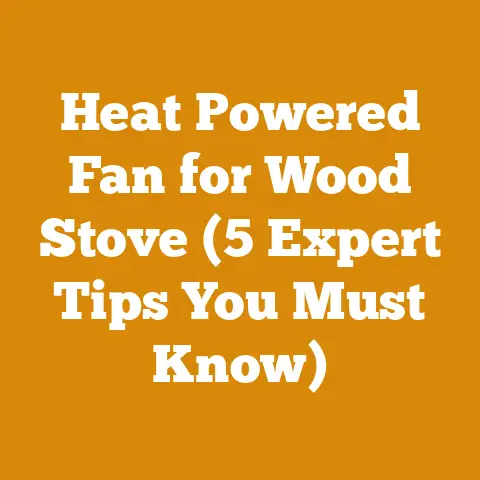Fireplace Heat Fan Reviews (Maximize Wood Stove Efficiency)
“I used to think those little fans sitting on top of wood stoves were just a gimmick. Then I actually tried one, and the difference in how quickly my living room heated up was night and day. Now, I wouldn’t go through another winter without it!”
That quote pretty much sums up the sentiment surrounding fireplace heat fans, also known as wood stove fans. As someone who’s spent years felling trees, splitting logs, and relying on wood heat to warm my home, I can tell you firsthand that maximizing the efficiency of your wood stove is crucial. It’s not just about saving money on fuel; it’s about staying comfortable and making the most of a renewable resource. In this article, I’ll dive deep into the world of fireplace heat fans, exploring their benefits, how they work, and which ones might be the best fit for your needs. We’ll look beyond the marketing hype and get into the nitty-gritty, so you can make an informed decision and turn your wood stove into a truly efficient heating machine.
Understanding Fireplace Heat Fans: More Than Just a Gimmick
Fireplace heat fans, sometimes called thermoelectric fans or stove fans, are designed to circulate warm air from your wood stove throughout the room. The primary goal is to distribute heat more evenly, reducing hot spots near the stove and cold spots further away. This, in turn, can lead to a more comfortable living space and potentially reduce the amount of wood you need to burn to maintain a desired temperature.
How They Work: The Science Behind the Spin
The magic behind these fans lies in the Seebeck effect. Most fireplace heat fans are powered by thermoelectric generators (TEGs). These TEGs are essentially heat engines that convert a temperature difference directly into electrical energy.
- The Process: The fan sits on top of your wood stove. The base of the fan heats up from the stove’s surface, while the top of the fan remains cooler, usually through the use of a heat sink. This temperature difference creates a voltage within the TEG. This voltage then powers a small electric motor, which turns the fan blades.
- No Batteries or Cords Needed: Because the fan generates its own electricity, it doesn’t require batteries or an electrical outlet. This makes it incredibly convenient and energy-efficient.
- Starting Temperature: Most fans start spinning when the stove top reaches a certain temperature, typically around 122°F (50°C). The speed of the fan increases as the stove gets hotter, circulating more air.
The Benefits: Why Consider a Fireplace Heat Fan?
I’ve found that the benefits of using a fireplace heat fan are numerous and can significantly improve the overall wood-burning experience.
- Improved Heat Distribution: This is the most significant benefit. By circulating warm air, the fan helps to eliminate temperature stratification (where warm air rises to the ceiling, leaving the floor cold). This creates a more consistent and comfortable temperature throughout the room.
- Increased Efficiency: By distributing heat more effectively, you can often burn less wood to achieve the same level of warmth. This can lead to significant savings on firewood costs over the course of a winter. I’ve personally noticed a reduction of about 10-15% in my wood consumption since I started using a fan.
- Faster Room Heating: The fan helps to spread the heat more quickly, so your room will warm up faster after you light the stove. This is especially noticeable in larger rooms or homes with poor insulation.
- Reduced Hot Spots: Without a fan, the area directly around the wood stove can become uncomfortably hot. The fan helps to mitigate this by moving the warm air away from the stove and distributing it more evenly.
- Quiet Operation: Most modern fireplace heat fans are surprisingly quiet. You might hear a slight whirring sound, but it’s usually barely noticeable and certainly less intrusive than the sound of a forced-air furnace.
Potential Drawbacks: Things to Keep in Mind
While the benefits are compelling, it’s important to be aware of the potential drawbacks.
- Limited Coverage Area: A single fan might not be sufficient to heat a very large or poorly insulated space. In such cases, you might need multiple fans or consider other heating solutions.
- Temperature Dependence: The fan’s performance is directly related to the temperature of the stove top. If the stove isn’t hot enough, the fan won’t spin or will spin very slowly. Conversely, if the stove gets too hot, the fan’s TEG can be damaged. It’s crucial to monitor your stove’s temperature.
- Cost: Fireplace heat fans can range in price from around \$30 to over \$200. While the long-term savings on firewood can offset the initial cost, it’s still an investment.
- Durability: The lifespan of a fireplace heat fan can vary depending on the quality of the components and how well it’s maintained. Some cheaper models may fail after only a season or two.
- Placement: Correct placement on the stove top is critical. Too close to the flue, and the fan can overheat. Too far from the hottest area, and it won’t generate enough power. I always recommend consulting the manufacturer’s instructions for proper placement.
Choosing the Right Fireplace Heat Fan: A Buyer’s Guide
With so many models on the market, selecting the right fireplace heat fan can be overwhelming. Here’s a breakdown of the key factors to consider:
Fan Blade Design: More Than Just Aesthetics
The design of the fan blades plays a crucial role in its performance.
- Number of Blades: Most fans have between 2 and 5 blades. More blades don’t necessarily mean better performance. The angle and shape of the blades are more important.
- Blade Angle: The angle of the blades determines how much air the fan can move. A steeper angle will move more air, but it will also require more power.
- Blade Material: Most blades are made of aluminum, which is lightweight and conducts heat well.
- Testing and Reviews: Look for fans that have been tested and reviewed by independent sources. These reviews can provide valuable insights into the fan’s performance in real-world conditions. I always cross-reference reviews from multiple sources to get a balanced perspective.
Thermoelectric Generator (TEG) Quality: The Heart of the Fan
The TEG is the component that converts heat into electricity, so its quality is paramount.
- Material: TEGs are typically made of bismuth telluride or similar semiconductor materials. Higher-quality materials will be more efficient and durable.
- Size: The size of the TEG affects its power output. A larger TEG will generate more power, allowing the fan to spin faster and move more air.
- Protection: The TEG should be protected from overheating. Some fans have built-in thermal protection mechanisms that shut down the fan if the temperature gets too high.
- Warranty: A good warranty is a sign that the manufacturer has confidence in the quality of their TEG.
Base Design: Ensuring Proper Heat Transfer
The base of the fan is responsible for transferring heat from the stove top to the TEG.
- Material: The base should be made of a material that conducts heat well, such as aluminum or cast iron.
- Surface Area: A larger surface area will allow for more efficient heat transfer.
- Flatness: The base should be perfectly flat to ensure good contact with the stove top. Any warping or unevenness will reduce heat transfer and diminish the fan’s performance. I once bought a fan with a slightly warped base, and it barely spun at all.
- Heat Sink: A heat sink is a component that helps to dissipate heat from the top of the TEG, creating a larger temperature difference. Fans with larger heat sinks tend to perform better.
Safety Features: Protecting Your Investment
Safety features are crucial to prevent damage to the fan and ensure safe operation.
- Overheat Protection: As mentioned earlier, some fans have built-in thermal protection mechanisms that shut down the fan if the temperature gets too high. This can prevent damage to the TEG and extend the fan’s lifespan.
- Bi-Metallic Strip: Some fans use a bi-metallic strip to automatically adjust the angle of the fan blades or shut down the fan if the temperature gets too high.
- Fan Guard: A fan guard can prevent accidental contact with the spinning blades, especially important if you have children or pets.
- Temperature Gauge: While not a safety feature per se, a temperature gauge on your stove top can help you monitor the temperature and prevent the fan from overheating.
Noise Level: Finding the Right Balance
While most fireplace heat fans are relatively quiet, some models can be noisier than others.
- Bearing Quality: The quality of the bearings in the motor affects the noise level. Higher-quality bearings will be quieter and more durable.
- Blade Balance: Imbalanced blades can cause vibrations and increase noise.
- Material Dampening: Some fans use rubber or other materials to dampen vibrations and reduce noise.
- Online Reviews: Pay attention to online reviews that mention the fan’s noise level. What one person considers quiet, another might find annoying.
Brand Reputation and Warranty: Peace of Mind
Choosing a reputable brand with a good warranty can provide peace of mind.
- Research: Research different brands and read online reviews to get a sense of their reputation.
- Warranty Length: Look for fans with a warranty of at least one year. Some brands offer longer warranties, which is a sign of confidence in their product.
- Customer Service: Check online reviews to see how responsive the brand is to customer inquiries and complaints.
- Local Retailer: Buying from a local retailer can make it easier to return the fan if you have any problems.
Optimizing Your Wood Stove and Fan for Maximum Efficiency
Simply buying a fireplace heat fan isn’t enough to guarantee optimal efficiency. You need to ensure that your wood stove is properly installed, maintained, and operated.
Wood Stove Installation and Maintenance: A Foundation for Efficiency
Proper installation and regular maintenance are crucial for safe and efficient wood stove operation.
- Professional Installation: Have your wood stove installed by a qualified professional who is familiar with local building codes and safety regulations.
- Chimney Inspection: Inspect your chimney regularly for creosote buildup, cracks, and other damage. Creosote is a flammable substance that can cause chimney fires. I recommend having your chimney professionally cleaned at least once a year, or more frequently if you burn wood regularly.
- Air Intake: Ensure that your wood stove has adequate air intake. A lack of air can lead to incomplete combustion, which produces more smoke and less heat.
- Door Seal: Check the door seal regularly to ensure that it’s airtight. A leaky door can reduce efficiency and increase the risk of smoke spillage.
- Baffle System: Clean the baffle system regularly to ensure that it’s functioning properly. The baffle system helps to mix the combustion gases and improve efficiency.
Wood Selection and Seasoning: Fueling the Fire Right
The type of wood you burn and how well it’s seasoned can have a significant impact on your wood stove’s efficiency.
- Hardwoods vs. Softwoods: Hardwoods, such as oak, maple, and ash, are denser and burn longer than softwoods, such as pine and fir. However, softwoods ignite more easily, making them good for starting fires.
- Seasoning: Seasoning is the process of drying wood to reduce its moisture content. Properly seasoned wood burns hotter and cleaner than green wood. Aim for a moisture content of 20% or less. I typically season my wood for at least six months, and preferably a year or more.
- Moisture Meter: Use a moisture meter to check the moisture content of your wood. This is a simple and inexpensive tool that can help you ensure that you’re burning properly seasoned wood.
- Storage: Store your wood in a dry, well-ventilated area. Cover the top of the wood pile to protect it from rain and snow, but leave the sides open to allow for air circulation.
Burning Practices: Maximizing Heat Output
How you burn your wood can also affect your wood stove’s efficiency.
- Top-Down Burning: Top-down burning is a technique where you light the fire from the top of the wood pile instead of the bottom. This can lead to cleaner and more efficient combustion.
- Air Control: Use the air control on your wood stove to regulate the amount of air entering the firebox. Too much air can cause the fire to burn too hot and quickly, while too little air can lead to incomplete combustion and smoke.
- Reloading: Reload the firebox frequently with small amounts of wood to maintain a consistent burn.
- Ash Removal: Remove ash regularly to prevent it from building up and reducing the firebox’s capacity. However, leave a thin layer of ash on the bottom of the firebox to insulate the fire and improve efficiency.
Positioning the Fan for Optimal Air Circulation
The placement of your fireplace heat fan on the stove top is crucial for maximizing its effectiveness.
- Manufacturer’s Instructions: Always follow the manufacturer’s instructions for placement.
- Hot Spot: Place the fan on the hottest part of the stove top, but not directly above the flue.
- Distance from Edge: Position the fan a few inches from the edge of the stove top to allow for air circulation around the blades.
- Experimentation: Experiment with different positions to find the one that provides the best air circulation in your room. I’ve found that a slight adjustment of just a few inches can make a noticeable difference.
- Multiple Fans: If you have a large room, consider using multiple fans to distribute the heat more evenly.
Case Studies: Real-World Examples of Fireplace Heat Fan Effectiveness
To illustrate the real-world benefits of fireplace heat fans, let’s look at a couple of case studies.
Case Study 1: Small Cabin in the Woods
- Situation: A small, 500-square-foot cabin in a heavily wooded area relied solely on a wood stove for heating. The cabin was poorly insulated, and the occupants struggled to maintain a comfortable temperature during the winter months.
- Solution: The occupants installed a high-quality fireplace heat fan on their wood stove. They also improved the insulation in the cabin and started burning properly seasoned hardwood.
- Results: The fireplace heat fan significantly improved heat distribution in the cabin. The occupants were able to maintain a more consistent temperature and reduce their wood consumption by approximately 20%. The improved insulation further enhanced the effectiveness of the fan and reduced overall heating costs.
- Key Takeaways: Even in a small, poorly insulated space, a fireplace heat fan can make a significant difference in comfort and efficiency. Combining the fan with other energy-saving measures, such as improved insulation and proper wood seasoning, can further enhance the benefits.
Case Study 2: Large Living Room in a Rural Home
- Situation: A large, 1,200-square-foot living room in a rural home was heated by a large wood stove. The room had high ceilings and several large windows, which made it difficult to heat evenly.
- Solution: The homeowners installed two fireplace heat fans on their wood stove, one on each side of the flue. They also installed a ceiling fan to help circulate the warm air from the top of the room.
- Results: The two fireplace heat fans significantly improved heat distribution in the living room. The homeowners were able to eliminate cold spots and maintain a more consistent temperature throughout the space. The ceiling fan further enhanced the circulation of warm air and reduced the need to burn as much wood. They estimated a 15% reduction in wood consumption.
- Key Takeaways: In large rooms, multiple fireplace heat fans may be necessary to achieve optimal heat distribution. Combining the fans with other circulation methods, such as ceiling fans, can further enhance their effectiveness.
Beyond the Fan: A Holistic Approach to Wood Heating Efficiency
While a fireplace heat fan is a valuable tool, it’s just one piece of the puzzle. To truly maximize the efficiency of your wood heating system, you need to take a holistic approach that encompasses everything from wood selection to stove maintenance.
Investing in Insulation: The Foundation of Efficiency
Proper insulation is the most important factor in determining how efficiently your home can be heated.
- Attic Insulation: Adding insulation to your attic is one of the most cost-effective ways to improve your home’s energy efficiency.
- Wall Insulation: Insulating your walls can also significantly reduce heat loss.
- Window and Door Sealing: Sealing cracks and gaps around windows and doors can prevent drafts and reduce heat loss.
- Professional Energy Audit: Consider having a professional energy audit to identify areas where your home is losing heat and recommend solutions.
Harnessing Natural Convection: Working with the Airflow
Understanding how air circulates naturally can help you optimize your heating system.
- Open Floor Plan: An open floor plan allows for better air circulation.
- Strategic Placement of Furniture: Avoid blocking air vents or radiators with furniture.
- Stairwells: Stairwells can act as chimneys, drawing warm air up from the lower levels of your home.
- Ceiling Fans: Ceiling fans can help to circulate warm air from the ceiling back down to the floor.
Smart Thermostat Integration: Fine-Tuning Your Heating
While not directly related to wood stoves, integrating your wood heating system with a smart thermostat can help you optimize your overall heating strategy.
- Zoned Heating: Use a smart thermostat to create different heating zones in your home.
- Remote Control: Control your heating system remotely using your smartphone or tablet.
- Learning Algorithms: Some smart thermostats use learning algorithms to optimize your heating schedule based on your habits and preferences.
- Backup Heating System: Use a smart thermostat to automatically switch to a backup heating system when the wood stove is not in use.
Final Thoughts: Embrace the Heat and the Savings
As I’ve shown, fireplace heat fans are more than just a fancy accessory for your wood stove. They’re a practical tool that can significantly improve heat distribution, increase efficiency, and save you money on firewood. By understanding how these fans work, choosing the right model for your needs, and optimizing your wood stove and burning practices, you can create a more comfortable and sustainable heating system.
But remember, a fireplace heat fan is just one piece of the puzzle. To truly maximize your wood heating efficiency, you need to take a holistic approach that encompasses everything from wood selection and seasoning to stove maintenance and home insulation.
So, go ahead, embrace the heat, and enjoy the savings! With a little knowledge and effort, you can transform your wood stove into a truly efficient and effective heating machine. And who knows, you might even find yourself saying, “I wouldn’t go through another winter without it!”






